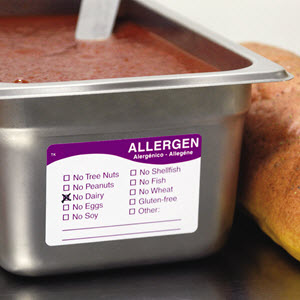How Food Service Can Help Keep Children with Allergies Safe
Posted on 19th Feb 2019

According to Food Allergy Research & Education (FARE), about 15 million people in the U.S. have food allergies, including nearly six million children under the age of 18. Further, 30% of these children are allergic to more than one food. For instance, they may have allergic reactions to peanuts, but may also be allergic to eggs or soy.
However, there is something else everyone in the food service industry should know: the number of people in the U.S. that must go to an emergency room or visit a doctor due to a food allergy reaction is rising dramatically. This is the conclusion of FAIR Health, an independent, non-profit organization that collects data based on health insurance claims.
In 2007, for example, FAIR Health found that 4.6% of the visits to doctors and emergency rooms were the result of severe food reactions. By 2016, that number had jumped to more than 22%. This means nearly one out of every four emergency room and doctor's visits are attributed to some type of food allergy.
And the reason for this increase?
According to Christina Ciaccio, interim head of the allergy and immunology department at the University of Chicago Medicine Comer’ Children’s Hospital, one prevailing theory is the hygiene hypothesis–that by parents and doctors becoming too good at keeping children safe, more children are developing allergies.
According to the hygiene hypothesis, the introduction of antibiotics and vaccines, while slashing infectious disease rates, have resulted in the immune system not being challenged the way it used to be. Ciaccio is not suggesting stopping vaccinating or prescribing necessary antibiotics. However, the hypothesis suggests that with children’s immune systems not being challenged as they were years ago, they may be less able to ward off disease as well as allergic reactions.
If the researchers’ hypothesis is correct, it would first appear that the food service industry is limited as to what it can do to address those allergies. However, there are options, and one of the most effective weapons is the new generation of cloud-based menu management systems that can help identify allergens so operators can properly label food and beverages.
At least one of these systems can analyze more than 60 individual nutrients in food items, to help locate and identify food allergens. And because the system is cloud-based, allergen information, along with all types of updates and regulations, can be shared at all locations in a food service organization at the same time.
Further, these systems can be used to print food labels that are easy to read, helping parents identify what is in the food their children are consuming. In fact, the reading of food labels is emphasized by the Asthma and Allergy Foundation of America. They recommend that when parents select food items for their children, they should read "every food label, every time.” While the cause for more allergies and the uptick in emergency room and doctors visits is unclear, food service can help mitigate these issues by ensuring all foods are properly labeled. With the help of cloud-based menu management systems, that’s easier than ever.
Article originally appeared on the Foodservice Director website.


